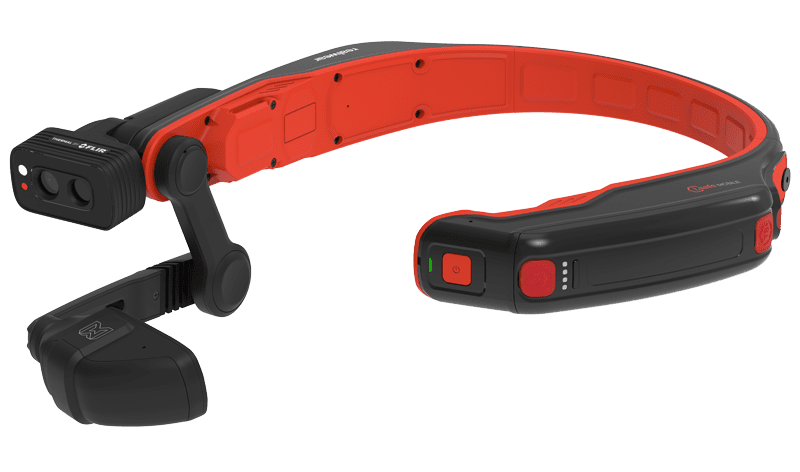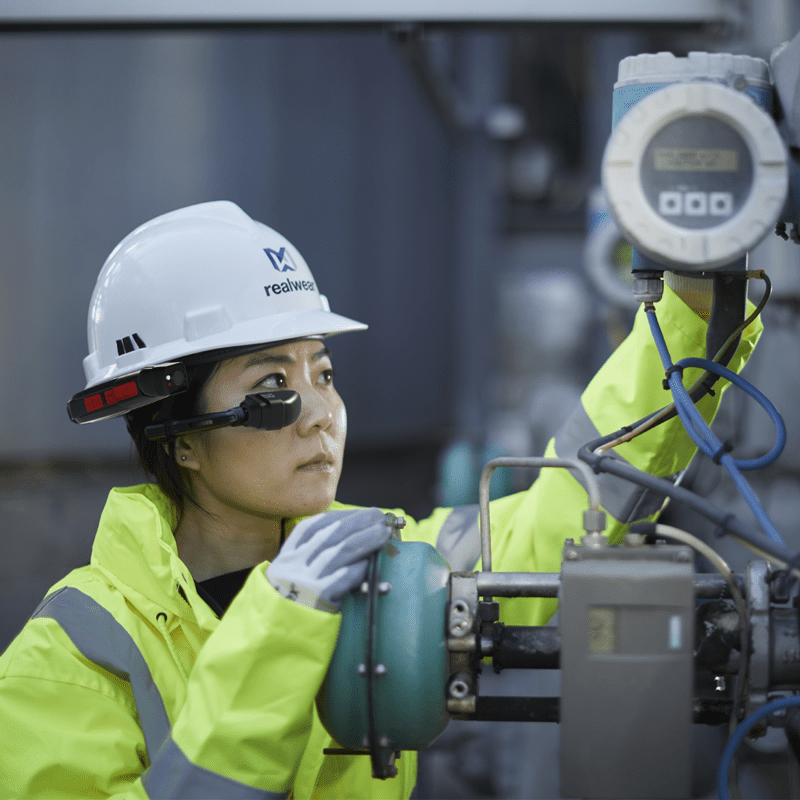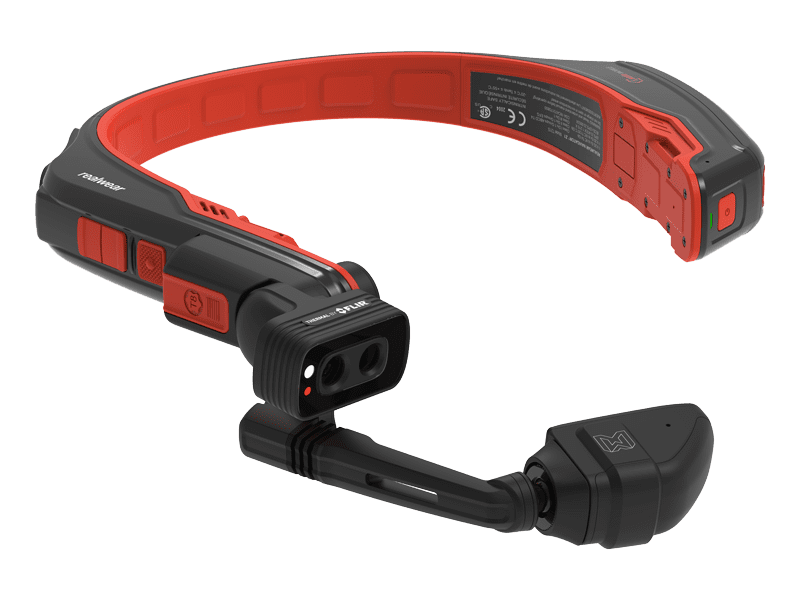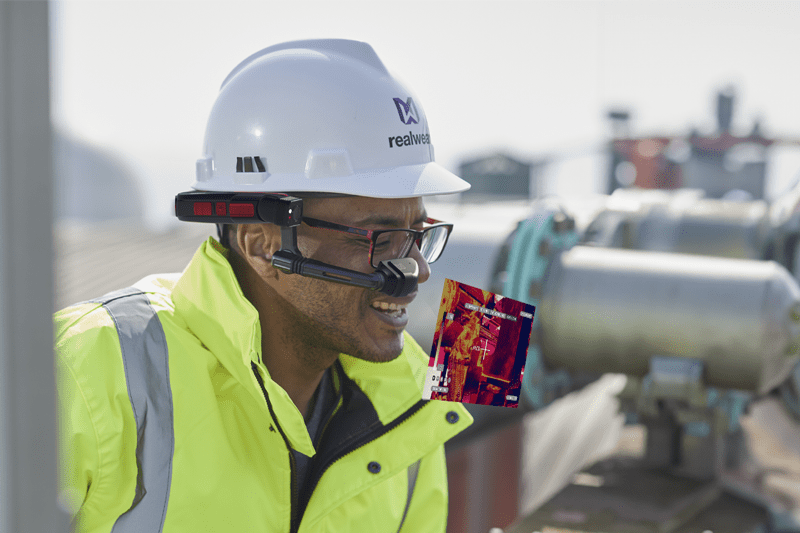In today’s fast-paced industrial environments, especially in sectors like oil and gas and renewable energy, efficiency, safety and innovation are key, and frontline workers in these industries face daily challenges that can directly impact operational performance and safety.
Whether they’re inspecting complex equipment, troubleshooting in hazardous environments, or ensuring smooth plant operations, they require the right tools to support them. Enter the RealWear Navigator Z1 with Thermal Camera, a game-changer in industrial smart glasses that offers the ability to work hands-free, enhanced by cutting-edge technology such as AI.
The Navigator Z1 is more than just another wearable; it’s a comprehensive solution that empowers workers to perform their tasks more safely, efficiently and accurately. With the integration of a thermal camera and AI capabilities, the device is tailored to the needs of modern frontline workers, and it’s set to revolutionize how tasks are completed in industries like oil, gas and renewable energy.
Certified for Hazardous Environments: ATEX Zone 1 and C1/D1
A key feature that sets the RealWear Navigator Z1 apart from other smart glasses is its ATEX Zone 1 and Class 1, Division 1 (C1/D1) certifications. These certifications make the Navigator Z1 a standout device for use in highly hazardous environments, such as oil refineries, chemical plants and offshore drilling platforms, where explosive gases or materials are present.

What Do ATEX Zone 1 and C1/D1 Certifications Mean?
The ATEX Zone 1 certification ensures that the RealWear Navigator Z1 is safe to operate in areas where there is a high risk of explosion due to flammable gases or vapors. This is crucial for the oil and gas industry, where frontline workers often operate in environments containing hazardous gases such as methane, propane or hydrogen sulfide. The device is designed to ensure that it won’t ignite these gases, thereby protecting workers from potentially catastrophic accidents.
Similarly, the C1/D1 certification, a North American standard, indicates that the Navigator Z1 can be used in areas where explosive gases or vapors exist under normal operating conditions. This is especially relevant in environments like oil rigs or chemical processing plants, where such hazards are part of everyday operations. With these certifications, RealWear has ensured that the Navigator Z1 meets the highest safety standards for use in industries where the consequences of equipment failure could be life-threatening.
The Power of Thermal Imaging
One of the standout features of the RealWear Navigator Z1 is its thermal camera. Traditionally, thermal cameras have been used by maintenance teams to detect heat anomalies in equipment, electrical systems or pipelines. This early detection of potential issues allows workers to address problems before they lead to costly downtime or, worse, catastrophic failures.
In the oil and gas industry, for example, equipment often operates under extreme pressure and high temperatures. Detecting any irregularities in heat distribution could be the difference between normal operations and an equipment breakdown or safety hazard. Similarly, in the renewable energy sector, thermal cameras help workers monitor solar panels and wind turbines, identifying hotspots that indicate malfunctioning parts.
By integrating a thermal camera directly into the RealWear Navigator Z1, frontline workers can instantly detect temperature variances while keeping their hands free to focus on other tasks. This combination of hands-free operation and real-time thermal feedback can allow for preventative maintenance and dramatically reduced response times, leading to safer and more efficient workflows.
Hands-Free Efficiency: Revolutionizing the Way Frontline Workers Operate
In industrial environments, time is money, and inefficiency can lead to unnecessary costs. Traditionally, frontline workers had to juggle between equipment manuals, hand-held cameras, and radios, all while wearing personal protective equipment (PPE). This multitasking can lead to errors, slow task completion, and an increased risk of accidents.
The RealWear Navigator Z1 is designed to eliminate these inefficiencies. With its voice-controlled interface, workers can access critical data, communicate with remote experts, and capture information without removing their hands from their tools or equipment. This is especially valuable in oil and gas fields, where workers often need both hands free to handle complex tasks while ensuring their safety.
In addition, the RealWear Navigator Z1 is fully PPE-compatible, designed to integrate seamlessly with hard hats, safety glasses, hearing protection, and other necessary safety gear. Workers in hazardous environments can wear the device comfortably alongside their existing PPE without any modifications or adjustments.

The design ensures there is no compromise on safety while improving operational performance.
For example, instead of flipping through manuals or calling for assistance, an engineer working on a gas compressor in a remote location can use voice commands to pull up relevant technical documents, while simultaneously using the thermal camera to inspect the equipment. Any issues can be documented and shared in real-time with off-site experts, who can offer guidance without the need for travel, saving both time and resources.
Safety and Accuracy in Hazardous Environments
One of the key priorities in sectors like oil, gas and renewable energy is worker safety. These industries frequently expose frontline workers to hazardous environments, whether it’s handling volatile materials, operating in confined spaces, or working at extreme heights. The RealWear Navigator Z1 helps mitigate these risks by allowing workers to access critical information and diagnostic tools without compromising their safety.
The thermal camera is particularly useful in detecting potential dangers that aren’t visible to the naked eye. In oil refineries or pipelines, thermal imaging can reveal gas leaks or abnormal temperature fluctuations, which are early indicators of equipment failure. By spotting these issues early, workers can take preemptive measures to avoid hazardous situations.
In renewable energy, where technicians often have to climb wind turbines or service solar panels, the Navigator Z1 allows them to stay focused on their tasks while capturing thermal data in real-time. The hands-free nature of the device means technicians can keep their hands on safety gear and tools, reducing the risk of accidents.

The Role of AI in Industrial Smart Glasses
As industries evolve, so do the technologies that support them. Artificial intelligence (AI) has become a transformative force across multiple sectors, and its integration into the RealWear Navigator Z1 brings an exciting array of possibilities.
With AI capabilities, the Navigator Z1 can go beyond thermal imaging and voice commands to offer predictive analytics, smart diagnostics, and even automated workflows. AI can assist frontline workers by identifying patterns in equipment performance, suggesting maintenance actions, and reducing human error in high-stakes environments.
In the oil and gas industry, AI-enhanced smart glasses can analyze data from equipment sensors, combined with thermal imaging, to predict issues before they occur. For example, AI algorithms could analyze heat signatures from a pipeline or pump and alert workers when the system is operating outside of optimal parameters. This level of insight not only boosts operational efficiency but also significantly reduces the risk of costly downtime.
Similarly, in renewable energy, AI can help technicians prioritize which wind turbines or solar panels need immediate attention, optimizing maintenance schedules and reducing manual inspections. By identifying trends in equipment performance, AI can also offer recommendations on how to extend the lifespan of assets, reducing operational costs.
Enhancing Collaboration and Remote Assistance
Another powerful feature of the RealWear Navigator Z1 is its ability to enhance collaboration through remote assistance. With the built-in thermal camera and AI capabilities, frontline workers can instantly share their real-time visual and thermal data with off-site experts, who can offer guidance and instructions from anywhere in the world. This reduces the need for on-site visits, enabling faster decision-making and troubleshooting.
In both the oil and gas and renewable energy sectors, this type of collaboration is invaluable. Technicians working in remote locations can connect with engineers or subject matter experts who might be hundreds of miles away, ensuring that complex problems are solved quickly and accurately.
The Future of Industrial Smart Glasses
As industries like oil, gas, and renewable energy continue to adopt advanced technologies, the demand for tools that enhance worker performance, safety, and efficiency will only grow. The RealWear Navigator Z1 with Thermal Camera is at the forefront of this transformation, offering a solution that integrates cutting-edge hardware and software in a seamless, user-friendly package.
Looking to the future, we can expect even more advancements in industrial smart glasses. AI will become more intuitive, capable of providing deeper insights and recommendations. Thermal imaging technology will become more refined, offering higher accuracy and sensitivity. And the devices themselves will become lighter and more ergonomic, further improving the user experience for frontline workers.
Industry Breakthrough
The RealWear Navigator Z1 with Thermal Camera is not just a tool; it’s a breakthrough in how industrial sectors like oil, gas and renewable energy operate. By offering hands-free thermal imaging, AI-powered insights, and real-time collaboration, combined with ATEX Zone 1 environments, the Navigator Z1 empowers frontline workers to work smarter, safer and faster in hazardous environments. As industries embrace these trends, RealWear will undoubtedly play a pivotal role in shaping the future of industrial work.
Headline photo: Users can carry out preventative maintenance with Thermal.





